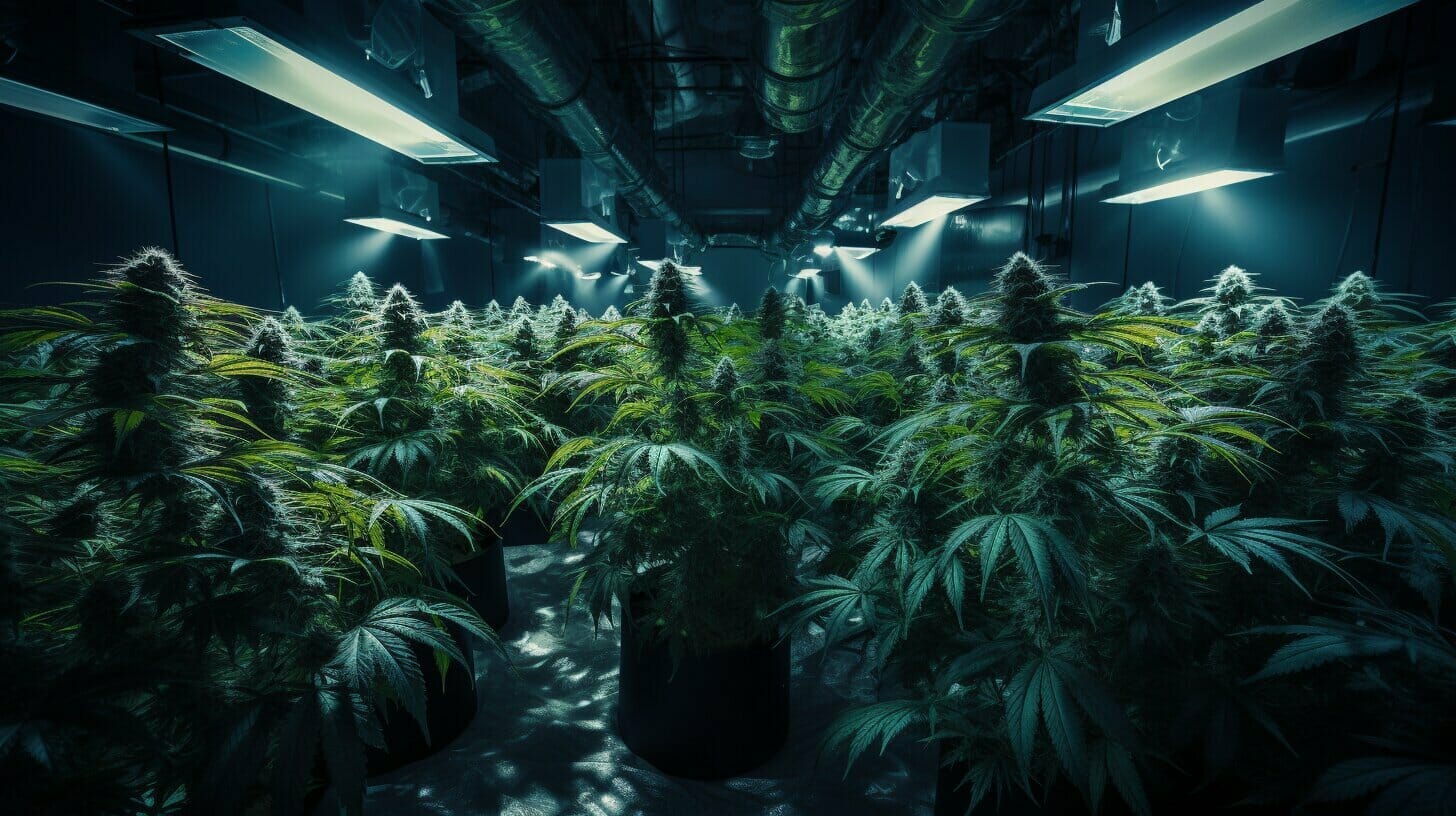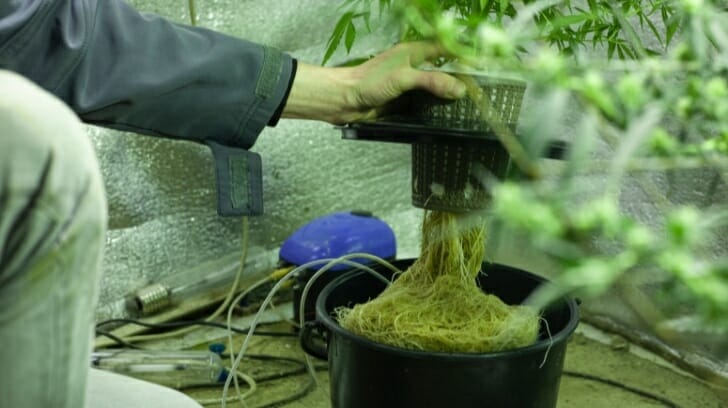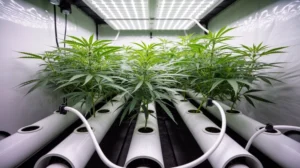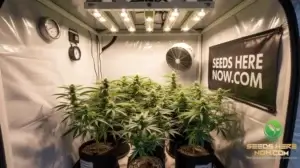Grow Marijuana Indoors: Expert Guide for Homegrown Success

Growing marijuana Indoors is becoming increasingly popular, and it’s no surprise why. When done correctly, it can yield a higher quality and quantity of cannabis compared to outdoor cultivation. If you’re looking for a successful homegrown experience, you’ve come to the right place. In this expert guide, we’ll provide tips and tricks on growing marijuana indoors.
One of the most crucial aspects of indoor marijuana growing is using high-quality seeds. That’s why we recommend SeedsHereNow.com as one of the best US seed banks. With their vast selection of strains, you can be sure to find the perfect seeds for your indoor cultivation needs.
Key Takeaways:
- Indoor cannabis cultivation can yield higher quality and quantity compared to outdoor cultivation.
- Using high-quality seeds from reputable sources like SeedsHereNow.com is crucial for successful indoor marijuana growing.
Choosing the Right Seeds to Grow Marijuana Indoors
Choosing the right seeds is crucial for successful indoor marijuana cultivation. Start by selecting a strain that suits your preferences and growing conditions. Indica strains are known for their short and stout stature, making them suitable for indoor growing, while Sativa strains tend to be taller and require more vertical space.
It’s important to source high-quality seeds from reputable seed banks. Seeds Here Now is considered one of the best US seed banks, offering a wide selection of quality seeds suitable for indoor cultivation. Make sure to choose fresh, tested, and genetically stable seeds.
Another factor to consider is the growing medium and method. Different strains may perform better in soil, coco coir, or hydroponic setups. Some seeds are also explicitly developed for specific growing techniques, such as ScrOG or SOG. Make sure to do your research and choose the right seeds for your preferred growing method.
Setting Up the Perfect Indoor Marijuana Grow Room
Indoor marijuana growing requires proper planning and setup to ensure a healthy and bountiful crop. Here are some key considerations:
| Location | Choose a location that provides adequate space, privacy, and security. Factors to consider include temperature, humidity, and lighting levels. |
|---|---|
| Environmental Factors | Controlling the temperature, humidity, and CO2 levels is essential for optimal plant growth. It is highly recommended that you invest in a reliable thermometer, humidifier, and CO2 monitor. |
| Lighting | Choosing the right grow light is crucial for indoor marijuana cultivation. Popular options include LED grow lights, metal halide lights, and high-pressure sodium lights. Ensure your plants receive at least 12 hours of light each day. |
| Ventilation | A sound ventilation system is critical for maintaining optimal temperature and humidity levels. Installing an exhaust fan, air filter, and ductwork will help improve air circulation and prevent mold and mildew growth. |
| Insulation | Proper insulation will help maintain a consistent temperature and humidity level in your grow room. Consider using reflective materials to improve light distribution and reduce energy costs. |
By properly setting up your indoor marijuana grow room, you can create an ideal environment for your plants to thrive. However, even with the best setup, choosing high-quality seeds and implementing proper care and feeding techniques is crucial to achieve a successful harvest.
Essential Equipment and Tools to Grow Marijuana Indoors
Indoor cannabis cultivation requires specific equipment and tools to ensure a successful harvest. To achieve the best possible results, experienced growers highly recommend investing in the following essential items:
| Equipment/Tools | Description |
|---|---|
| Grow Lights | High-quality grow lights are essential for indoor cannabis cultivation. LED lights are the most popular choice due to their energy efficiency and high output, but other types of lighting, such as high-pressure sodium and fluorescent lights, can also be used. |
| Grow Tents | Grow tents provide a controlled environment for indoor cannabis cultivation. Depending on the grower’s needs, they are available in various sizes and designs. |
| Ventilation Systems | Proper ventilation is crucial to maintaining a healthy, growing environment for cannabis plants. Growers can opt for either passive or active ventilation systems, depending on their budget and space constraints. |
| Hydroponic Systems | Hydroponic systems enable growers to cultivate cannabis without soil. These systems offer a more efficient and controlled way of delivering nutrients to plants, resulting in faster growth and higher yields. |
| Tools | Cannabis cultivation requires specific tools for maintenance and harvesting. Some examples include trimming scissors, drying racks, humidity meters, and pH testers. |
Investing in high-quality equipment and tools can significantly improve the outcome of indoor cannabis cultivation. Choosing equipment and tools that match the grower’s needs and budget is essential to ensure a successful harvest.

Nutrients and Feeding Schedule for Indoor Marijuana Plants
Proper nutrition is essential for the growth and development of indoor marijuana plants. Choosing the proper nutrients and maintaining the correct fertilizers for your crop significantly affects your crop’s yield. For nutrients for your indoor marijuana plants, consider the growth stage and the soil or hydroponic system you’re using. Many kinds of nutrients are available, including organic and synthetic options.
Organic nutrients are derived from natural sources and are often less harsh than synthetic options. They may also provide additional benefits such as improving the soil’s microbial activity. Synthetic nutrients, on the other hand, are designed for specific stages of growth and can be more precise in providing the necessary nutrients.
Feeding Schedule
Establishing a feeding schedule for your indoor marijuana plants is crucial for optimal growth. It’s recommended to start with a lower concentration of nutrients and gradually increase the strength as the plant grows.
The feeding frequency will vary depending on the type of soil or hydroponic system you’re using. Generally, giving your plants nutrients is best every two to three waterings. Overfertilization can lead to nutrient burn and other complications, so it’s essential to be cautious and monitor your plants’ response to the feeding schedule.
Maintaining Optimal pH Levels
The soil or hydroponic solution’s pH level can significantly impact the plant’s uptake of nutrients. Indoor marijuana plants prefer a slightly acidic pH range of 5.5 to 6.5. To maintain optimal pH levels, you can use pH testing kits or adjust the pH with solutions such as phosphoric acid or potassium hydroxide.
Common Mistakes to Avoid
One of the most common mistakes in indoor marijuana cultivation is overfertilization. This can lead to nutrient burn and other complications that can harm the plant. To avoid overfertilizing, it is essential to follow a feeding schedule and monitor the plant’s response to nutrients.
Another mistake is not adjusting the pH levels of the soil or hydroponic solution. Neglecting pH levels can result in nutrient deficiencies or toxicities, damaging the plant.
Finally, be cautious of nutrient lockout, which occurs when the plant cannot absorb nutrients due to imbalanced pH levels, soil compaction, or other factors. Regular flushing and maintaining proper pH levels can help prevent nutrient lockout.
Managing Pest and Disease Control When You Grow Marijuana Indoors
Indoor cannabis cultivation offers a controlled environment that can help you keep pests and diseases at bay. However, it’s not without its risks, and common pests and diseases can still wreak havoc on your marijuana plants if not appropriately managed. This section will cover some of the most common issues and provide insights into preventive measures and organic pest control methods.
Identifying Common Pests and Diseases
The first step in preventing and managing pests and diseases is identifying them. Some of the most common pests that may affect indoor cannabis cultivation include spider mites, aphids, and whiteflies. Diseases such as powdery mildew and bud rot can also threaten your crop.
To prevent the spread of pests and diseases, it’s essential to monitor your plants closely and check them regularly for signs of damage. This includes inspecting the leaves, stems, and buds for discoloration, spots, and other abnormalities. You can also use a magnifying glass to examine the underside of leaves for signs of pests.
Preventive Measures
The best way to manage pests and diseases is by preventing them from entering your grow space in the first place. This can be achieved through a variety of means, including:
- Keeping your indoor garden clean and free of debris that could harbor pests and diseases
- Quarantining new plants or clones to prevent the spread of pests or diseases
- Installing screens on windows and vents to prevent pests from entering your grow room
- Washing your hands and changing your clothes before entering the grow room to prevent the introduction of pests and diseases
Organic Pest Control Methods
If you do encounter pests or diseases despite your preventive measures, there are several organic pest control methods that you can use to manage them. These include:
- Neem oil: A natural insecticide that can be sprayed onto your plants to deter pests
- Diatomaceous earth: A powder made from fossilized diatoms that can be sprinkled around your grow space to kill crawling insects
- Beneficial insects: Predatory insects such as ladybugs and praying mantises can be introduced to your grow space to eat pests
By taking preventive measures and using organic pest control methods, you can effectively manage pests and diseases in your indoor cannabis cultivation. Regular inspection and maintenance of your grow space is key to a healthy and prosperous crop.
Indoor Hydroponic Systems: Advantages and Techniques
Indoor hydroponic systems are popular for cannabis cultivation due to their many advantages over traditional soil-based methods. These systems use water and nutrient solutions to feed the plants directly, eliminating the need for soil and providing precise control over growing conditions. Here are some of the main advantages and techniques for optimizing indoor hydroponic systems:
Advantages of Hydroponic Systems for Indoor Cannabis Cultivation
| Advantages | Benefits |
|---|---|
| Faster Growth | Plants grow up to 50% faster than traditional soil-based methods |
| Higher Yield | Plants produce larger and denser buds in hydroponic systems |
| Water Efficiency | Hydroponic systems use up to 90% less water than soil-based methods |
| Precise Control | Growers have complete control over the nutrients, pH, and other environmental factors for optimal growth. |
These advantages make hydroponic systems attractive for those looking to maximize their indoor cannabis yields while minimizing their environmental impact.

Hydroponic Techniques to Help Grow Marijuana Indoors
Several hydroponic techniques can be used for indoor cannabis cultivation, including:
- Drip Irrigation: This method uses a timer to drip nutrient solution onto the plant’s roots.
- Flood and Drain: Also known as ebb and flow, this method floods the grow container with a nutrient solution and then drains it repeatedly to provide oxygen to the plant roots.
- Aeroponics: This method uses a misting system to deliver nutrient solution directly to the plant’s roots.
Each technique has its advantages and disadvantages, so it’s essential to research and select the best method for your specific needs.
Some tips for optimizing hydroponic systems include:
- Use high-quality nutrient solutions that are specifically formulated for cannabis plants.
- Monitor pH levels regularly and adjust as needed to ensure optimal nutrient uptake.
- Ensure proper ventilation and air circulation to prevent mold growth and harmful bacteria.
- Keep a close eye on nutrient solution levels to ensure that plants receive the proper nutrients.
- Clean and disinfect the system regularly to prevent the buildup of harmful pathogens.
When set up and maintained correctly, indoor hydroponic systems can provide a reliable and efficient method for cultivating high-quality cannabis plants.
Tips: If you plan to Grow Marijuana Indoors
Indoor gardening requires careful attention to detail to ensure success. Here are some tips and techniques to help you maintain healthy and thriving cannabis plants:
- Pruning and Training: Regular pruning and training help control the shape and size of your plants, improve light penetration, and increase yield. Use pruning shears to trim away dead or damaged leaves and branches, and train your plants using stakes or ties to encourage them to grow in a specific direction.
- Humidity Control: High humidity levels can promote the growth of mold and mildew, while low humidity can cause your plants to wither and die. Use a hygrometer to monitor humidity levels in your grow room and adjust them as needed using a dehumidifier or humidifier.
- Monitoring Plant Health: Watch your plants closely for signs of stress, nutrient deficiencies, or pests. Regularly inspect the leaves and stems to spot any issues early and treat them promptly.
- Choosing the Best Grow Lights: Invest in high-quality grow lights that mimic natural sunlight to optimize plant growth and yield. LED grow lights are popular due to their energy efficiency and long lifespan.
Tip: If you’re new to indoor gardening, start with a small setup and experiment with different techniques to find what works best for you and your plants. Don’t be afraid to adjust your approach over time as you learn and grow as a cultivator!
Growing Marijuana Indoors: Conclusion
Successfully growing marijuana indoors requires attention to detail, dedication, and patience, but with the proper knowledge and tools, it can be an enriching experience. By choosing high-quality seeds from trusted sources like SeedsHereNow.com, setting up the perfect grow room, providing adequate nutrition, managing pests and diseases, and utilizing hydroponic systems, you can optimize the growth and yield of your indoor cannabis cultivation.
Keep Learning and Experimenting
Remember, cannabis cultivation is a constantly evolving field, so keep learning and experimenting with different techniques and methods to find what works best for you. And always stay informed about laws and regulations regarding cannabis cultivation in your area to ensure compliance.
With the right mindset and approach, you can enjoy the benefits of growing your high-quality marijuana indoors.
FAQ
Q: Can I grow marijuana indoors?
A: Yes, you can successfully grow marijuana indoors. With the proper knowledge, equipment, and techniques, you can create an optimal environment for your plants to thrive.
Q: Where can I find high-quality seeds for indoor cultivation?
A: You can find high-quality seeds for indoor cultivation from reputable seed banks such as SeedsHereNow.com. They are considered among the best US seed banks and offer many strains.
Q: What factors should I consider when choosing seeds for indoor marijuana cultivation?
A: When choosing seeds for indoor marijuana cultivation, consider factors such as strain selection, seed quality, and sourcing from trusted seed banks. Selecting strains suitable for indoor growing is essential, ensuring the seeds are of high quality. How do I set up the perfect indoor marijuana grow room?
A: Setting up the perfect indoor marijuana grow room involves choosing the correct location, controlling environmental factors such as lighting and ventilation, and ensuring proper insulation. These factors play a crucial role in the success of your indoor cultivation.
Q: What essential equipment and tools do I need for indoor cannabis cultivation?
A: Essential equipment and tools for indoor cannabis cultivation include grow lights, tents, ventilation systems, hydroponic systems, and other necessary tools. These tools help create and maintain optimal growing conditions for your plants.
Q: How do I provide the proper nutrients for my indoor marijuana plants?
A: Providing the proper nutrients for indoor marijuana plants involves selecting high-quality fertilizers, following a feeding schedule, and maintaining optimal pH levels. It is important to ensure your plants receive the necessary nutrients for healthy growth.
Q: How do I manage pests and diseases in indoor cannabis cultivation?
A: Managing pests and diseases in indoor cannabis grows requires preventive measures, organic pest control methods, and in some cases, beneficial insects. Regular monitoring and early detection are essential for maintaining a healthy crop.
Q: What are the advantages of using hydroponic systems for indoor marijuana cultivation?
A: Hydroponic systems offer advantages such as faster growth rates, higher yields, and more precise control over nutrient delivery. They are an efficient and space-saving option for indoor marijuana cultivation.
Q: What are some additional tips for indoor gardening and maintenance?
A: Some additional tips for indoor gardening and maintenance include using pruning and training techniques, managing humidity levels, monitoring plant health, and selecting the best grow lights for indoor plants. These practices help promote healthy growth and maximize yields.
Suggested Articles
;)
;)
;)




 03 Dec 2025
03 Dec 2025  7 min read
7 min read


 August 05, 2023
August 05, 2023 


RESPONSES (0)
No responses yet. Be the first to respond!